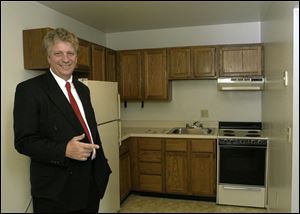
Priced out of apartments
10/19/2003
Jim Moody, in a budget apartment in West Toledo, says the city has a plentiful stock of affordable housing.
IF YOU WORK for minimum wage or rely solely on government assistance, your chances of finding an affordable small apartment in northwest Ohio are better than in much of the country.
Prospective tenants should be able to easily find a studio apartment including utilities for under $300 a month in eight rural area counties and for under $390 in Lucas, Wood, and Fulton counties, according to a recent study by the National Low Income Housing Coalition.
Those numbers are far closer to the country's lowest rates than to its highest. Across the nation, the study found typical studio apartment rents range from $1,300 in California's San Jose area to less than $250 in rural North Dakota.
Still, 30 percent of tenants in the greater Toledo area would need to spend more than an acceptable amount of their income on rent and utilities for a median-priced studio apartment, the study found.
In Ohio, the study listed rates for studio apartments at $400. The greater Cleveland area had the highest such price in the state at $485. The state's cheapest rates, almost $300, were estimated for 33 counties, including Erie, Hardin, Ottawa, Paulding, Sandusky, Seneca, Van Wert, and Wyandot locally.
The crux of the low income housing group's study was that in many cities, minimum-wage earners and government aid recipients aren't able to easily find an affordable apartment without applying for subsidies.
The study highlights metropolitan areas on the coasts where the cost of living and median incomes are far higher than in northwest Ohio and where apartments are less affordable to low-income people.
But in much of northwest Ohio, a person who is paid minimum wage of $5.15 an hour would need to work 44 hours a week to afford a $300 studio apartment without spending more than 30 percent of his income on rent and utilities, the study found. That share of income is considered the most that is acceptable for rent for a household.
It is unclear how many local families in poverty might be searching for rental housing on the open market. Subsidized housing, which the study does not include in its figures, appears plentiful in the area. The Lucas Metropolitan Housing Authority typically can find apartments in about two months for people who are at least 62 years old or who are disabled, but finding an apartment for a family can take four to eight months, a spokesman for the housing authority said.
The study compiled apartment rent and personal income figures from the U.S. Bureau of Labor Statistics and Department of Housing and Urban Development.
Some of the figures cited are the median rate of apartments, but most are figured at slightly below the median to more closely reflect the cost of a modest apartment in the area. The median rate is the midpoint between the highest and lowest figures.
The Toledo region is not a prime example used by the coalition in seeking more assistance for the poor, because area rents are generally more affordable.
“Northwest Ohio is the best, most affordable housing market anywhere,” raved Jim Moody, a partner in Flex Realty Property Management, Sylvania Township, which manages more than 400 apartments and houses in greater Toledo.
He was showing a one-bedroom, 500-square-foot apartment in a complex built in 1969 near Franklin Park Mall that was listed at $360 a month, with heat included.
Rental rates have held steady in the past few years, he said, in part because many apartments have been vacated by people moving into houses.
“The economy has been so good, it took so many potential tenants out of the rental market and made them homeowners,” he said. More programs to help low-income residents buy homes in recent years also have taken some families out of rentals.
One of the cheapest apartments advertised in Toledo this month was a small studio with a tiny bathroom and galley kitchen on Cherry Street near St. Vincent Mercy Medical Center for $185 a month, which included water but no other utilities.
In the same building, another apartment is rented at $150 a month, said Joe Hall, office manager of Robert F. Lindsay Realty, which manages the property. Such low rates come with tradeoffs. That apartment has its own bathroom, but getting to it means walking out the door into a public hallway.
Most likely to be struggling with housing are families with young children who are at the poverty line, said Danilo Pelletiere, the housing coalition's research director. Families would have more reasons to worry about apartments that have peeling paint or are in poor school districts and would be more likely to want more space, he said.
For larger apartments, the price difference across the country grows, according to the coalition study. In northwest Ohio, the lowest two-bedroom apartment estimate, figured at just under the median, is $439 a month including utilities in six rural counties. In Lucas, Wood, and Fulton counties, the comparable rate is $574.
In the San Jose metro area, the rate is more than $1,800. The lowest in the country, $370, is in rural Alabama counties.
Michigan's rates are higher than Ohio's, the coalition found. It lists $445 as just under the median for a studio apartment with utilities in Michigan. Along the Ohio line, though, its estimates range from $310 in Hillsdale County to $550 in Lenawee County.